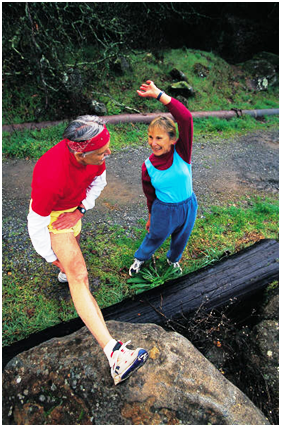A Common-Sense Approach to Exercise
 Be Smart.
Be Smart.
Before you start a fitness program, check with your doctor.
Maintain Balance.
Depending on your goals, a complete fitness plan should include aerobic activity (running, swimming), strength training, and flexibility. If fitness is new to you, start with light to moderate aerobic activity. This means you should be able to talk or sing during exercise.
Set small, realistic goals, such as strolling around the mall or your neighborhood for 20-30 minutes, or walking the dog when you get home. As stated, follow any instructions given by your doctor.
Get Creative.
If the weather is bad, choose a building and walk/jog the stairs. You can work in intervals by jogging up and walking down, resting 30 seconds in between sets. Mix it up by walking sideways, backwards, or on the balls of your feet. This way you can work a variety of muscles.
Who needs equipment? Playground fitness is just as fun! Park benches, picnic tables, and jungle gyms can all be used as your own personal fitness equipment when you can’t get to the gym.
Put your best foot forward.
Be picky when choosing your footwear. It should fit every aspect of your foot and give you the right amount of support and cushioning. Do research on the web before shopping to see which shoe best suits your feet.
Foot problems can turn into serious issues. Be sure to take care of small things like:
- blisters
- bone bruises
- swelling.
See your doctor if problems persist.
Your body knows best.
Always listen to how your body is feeling; it speaks the truth! At the start of your fitness program, you may feel sore—and that is okay. But beware of constant pain.
Increase how often you exercise slowly. This way you can build endurance. When an exercise becomes easier, try increasing how long or how hard you exercise.
Stay Hydrated.
Drink eight, 8oz. glasses of water each day. When exercising, keep water handy and take a sip at least every 15 minutes. If you are exercising in extreme climates, drink more often. Save one cup of water to hydrate after your workout. This will help you get rid of toxins and help prevent cramps.
Safety First.
When it comes to fitness, proper form is key to avoiding injury. The right body alignment can help reduce orthopedic stress to your body. It will also make you less likely to be injured.
Most machines have specific highlighted instructions posted on the frame, including what muscles you are working. Follow these steps so you can exercise in a safe manner.
Personal trainers are also a great tool in learning a new fitness program or facility. Your personal trainer can guide you through proper form and technique, giving you the most out of your routine.
Know the warning signs.
Stop exercising if you have:
- abnormal heart rhythm, pain, or pressure in your chest
- dizziness
- light-headedness
- nausea during or after exercise
- prolonged fatigue or insomnia.
Check with your health care provider if your symptoms persist.
Catch some ZZZZZZZs.
Keeping the same sleep schedule can help your body regulate your metabolic rate. Lack of sleep can disrupt your body’s internal clock, causing problems.
To get a good night’s rest, avoid caffeine within a few hours of bedtime and allow yourself plenty of time to wind down before turning in for the night. Regular physical activity will also help you sleep better.
Make a master plan.
The best recipe for way to succeed is by leaving little room for distractions. Begin your week by creating an exercise plan with goals for each day. Do the same for nutrition and sleep. At the end of each day, mark off the activities that you completed and the goals you reached. Seeing your accomplishments on paper not only holds you accountable for your actions but also does wonders for your motivation.
Keep your body guessing.
While treadmill walking is a great way to begin your program, it is ideal to switch with a lower impact activity, such as:
- elliptical
- arc trainer
- rower.
Mixing up your routine will not only give you better results, but it will also work different muscle groups and relieve your joints from ongoing impact of the treadmill or walking outdoors.
Group fitness classes are also great ways to make your fitness routine fun and ever-changing. They provide the added bonuses of group support and guidance from the instructor.
Have fun!
Remember that exercise was designed to keep our bodies active. That doesn’t mean you have to work out in a fitness center or on a machine. Stay active doing things you loved to do as a child, like roller skating, playing tennis or dancing. You will be more likely to stick to a regular fitness program if you include activities that you enjoy.
This article was originally authored by Carolyn Nickol, Director, University Fitness Center, NetWellness.org.
For more information:
Go to the Exercise and Fitness health topic.
 Be Smart.
Be Smart.